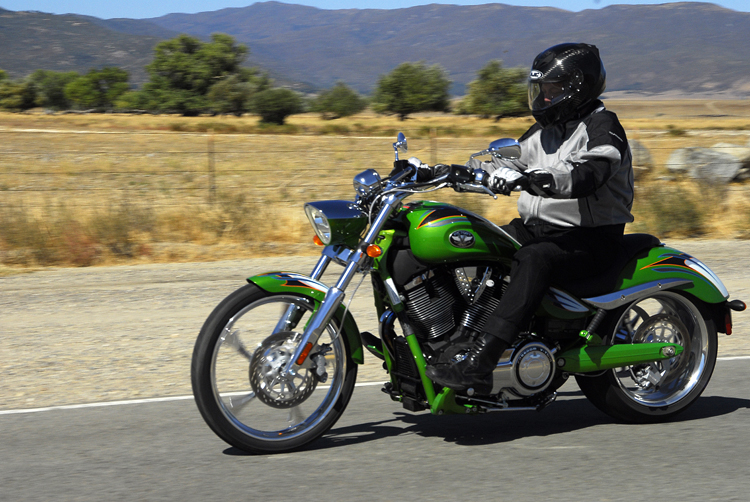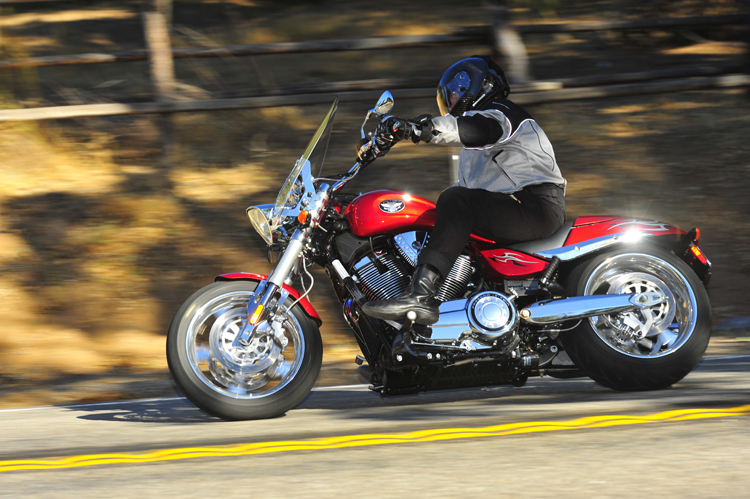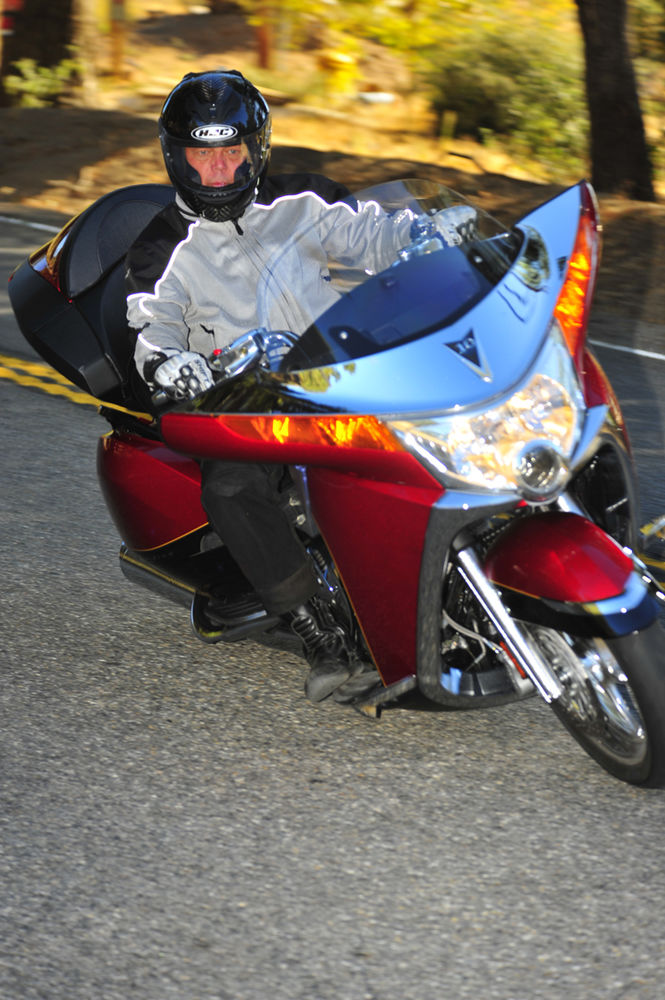2009 Victory Launch

Minnesota-based Victory Motorcycle division of Polaris Industries continues to celebrate its 10th anniversary, a milestone few new startup manufacturers reach in this competitive field and these difficult times. Recently Victory Motorcycles offered the press a viewing of the 2009 model lineup, along with some customs, at the Art Center College for Design, which we covered in the December issue. "The New American Motorcycle" brand has since held a riding event near San Diego, California, where we could sample the entire lineup of bikes.
San Diego County is an excellent place for motorcycling almost year-round, with near-perfect weather, great scenery and wonderful mountain roads. This day also came with moderate temperatures, sunny skies and light traffic; so the gods of motorcycling were smiling on us during our model tryouts.
The full day's ride was divided into segments where we could ride each model, switching between bikes at pre-determined locations. Our first test bike was the Kingpin Pinball, a blacked-out machine that has the "smaller" 100-cubic-inch Freedom engine with a five-speed transmission, 130/70-18 and 180/55-18 tires, and starting at under $ 14K. Stripped down to the essentials, it's targeted for anyone wanting a brand-new V-twin that provides excellent cruiser performance on a budget. We like the way the bike looks, turns and runs, and it can be accessorized with saddlebags and a windscreen for touring duties. We'd prefer to have the six-speed gearbox and a more comfortable dual seat for extended rides, however.

Next up was the flashy Vegas Jackpot, what Victory calls a custom cruiser, and it comes with the more powerful 106-inch version of the Freedom engine with a six-speed transmission, starting at $ 18,499. Torque is plentiful and the machine accelerates with authority. The Jackpot's 21-inch front wheel, paired with a 250-width rear tire, looks very cool but resists turning, requiring the rider to hold the bike firmly in a turn. We like its appearance, but the standard Vegas, which gets the still-potent 100-inch engine, six-speed and 180-width rear rubber, turns and rides better and sells for $ 2,200 less.
After the Jackpot, we rode a Hammer. Victory's power cruiser also sports a fat 250-width tire and is powered by a 106-incher that's calibrated for even more power. As we descended the long, steep serpentine grade to the desert town of Borrego Springs, California, the view was breathtaking and the riding more challenging. The vast Salton Sea simmered in the midday sun, and with more than 100 miles of visibility, the hills of northern Mexico could be seen on the horizon. When the corners tighten, the brawny Hammer tempts the throttle hand - urging more speed - but the low-slung chassis scrapes too easily in corners, especially in left-handers. Also, the seat is quite hard and the suspension firm with little travel; so bumps are felt strongly. Riding through towns and suburbs, the 250mm fat-tire bikes are in their element; but out here they leave you wishing for a narrower 180.

We also did a brief stint on the Cory Ness Vegas Jackpot ($ 24,499), which looks very custom, runs and works well and draws lots of attention. However, the knurled-metal Ness handgrips are really tough on the hands (or gloves) and difficult to hold onto for extended periods. Give me the bike, but ditch the grips.
Last but not least, we rode the flagship of the lineup, the Ness Vision, which is easily distinguished from the rest by its flashy graphics. (We also had a Vision Street for several days before and after the introduction, and rode it for hundreds of miles for more impressions.) As we climbed the long steep grade from the desert floor at Borrego Springs to the mountain town of Julian, the hot, dry air gradually gave way to refreshingly cool pine scents. The torque of the 106-inch engine propelled the Vision upward with power to spare, and the six-speed gearbox always had an appropriate ratio for the task at hand. It's surprising how far you can lean the Vision over before anything scrapes. Other cruisers have taught us to expect a grinding noise from the footboards going through intersections and moderate-speed corners; so this one's amenable attitude is a pleasant revelation.

The Vision series is big news for touring enthusiasts checking out both Street and Tour models, with the latter having a large tail trunk that adds a considerable amount of extra storage. These models were introduced as 2008 models and a test of the Tour version appeared in our September/October issue. Since that RoadRUNNER test, several changes have been made, including an available reverse, appearance options, and minor changes to the dash and stereo. For 2009, Victory briefly offered 100 limited-edition 10th Anniversary Visions, which sold out in an incredible seven minutes after they became available to order on the Internet.
Visions are a pleasure on the highway. Purring along at a relaxing 3,000 rpm in sixth at 80 mph, there's plenty of zip for passing, even without downshifting. The lower four ratios tend to produce quite a bit of gear noise, but fifth and sixth are quiet. On our ride south to San Diego, temperatures hit 101 degrees. But even in those searing conditions, the bike never showed any signs of overheating, although the heat from the rear exhaust certainly warms the rider's right leg!

With plenty of room for two large adults, the Vision never feels crowded and, with the 26.5-inch seat height, shorter riders can still reach the ground. The rider can look over the top of the electrically operated windscreen in its lowest position, and the extra airflow is welcome when riding at lower speeds in hot weather. A push of the button raises the screen to just above eye level, which effectively blocks the wind at higher speeds without buffeting and allows the stereo to be heard clearly.
Nonetheless, we noted some rough spots where there's room for improvement. Right after a fill-up, the gas gauge never read higher than about three-quarters full. Fortunately, the more-critical lower section of the gauge seemed to be spot on, and the low-fuel indicator is easy to see. The cruise control is simple to use, but it surges annoyingly, and all of the Visions we rode did this to varying degrees. And though the saddle bags may look large on the outside, their swooped, curved design limits interior room.
Parting Thoughts
All of the engines start and run very well, with glitch-free fuel injection, strong torque, plenty of horsepower and a nice wide powerband. Clutches are chatter-free and they hook up well. The transmissions shift with an authoritative "clack" without false neutrals or missed gears; lever effort is moderate; and shifts are relatively quick for the cruiser world. The models that get dual front brake calipers deliver strong, fade-free and consistent stopping power, but even the single-front-caliper bikes stop well.
Every time we attend a Victory press launch, we're pleased to see the enthusiasm of the manufacturer's staff and the continual improvements across the product line. We're also very favorably impressed at how dependable these bikes are. Not one bike on any of the Victory launches I have been on, or the test bikes I've ridden more extensively, have developed any type of problems or broken down. Based on these experiences, we think the Victory models offer top quality - thanks to world-class manufacturing methods, factories and testing facilities, along with dedicated employees and management. For more information visit www.polarisindustries.com or your local dealer.
On Partnerships & Planning
At the press event, we asked Mark Blackwell, Vice President of Victory Motorcycles & International Operations, "Now that Victory has reached its 10th anniversary, where do you think the company is going in the next decade?" Blackwell stated, "Right now the market environment is very tough, but we try to look well beyond the current situation, and while the industry is slow at the moment, we have plans out 10 to 15 years. Last summer, our board of directors and management spent about four months laying out a strategy for the next ten years. What I can tell you is that we expect a large, healthy motorcycle business. To get the company [Polaris] where we want it to be by 2017, which is a $ 5-billion company, motorcycles are a very big part of that. We want to be more on-road [Polaris sells ATVs, snowmobiles, etc.], more global, and get more into military products. Motorcycles are a very key part of that strategy. Today Victory is only six or seven percent of Polaris' total revenue, and we need to get that up to 10 percent or more. Since our relationship with KTM didn't work out like we hoped, we have to expand into more segments and/or expand with partnerships or acquisitions."












